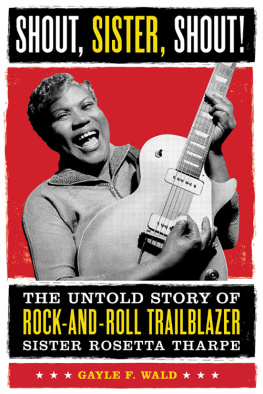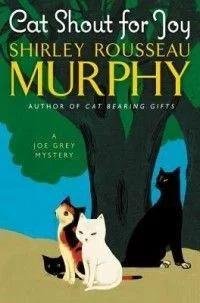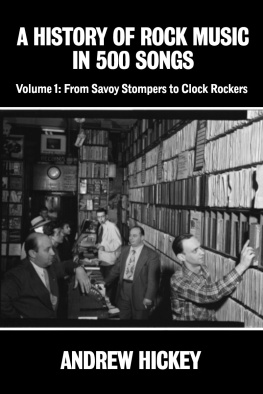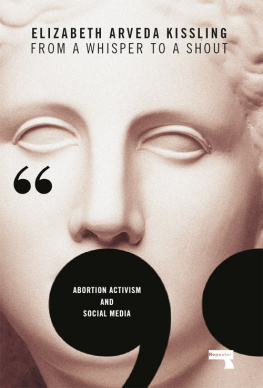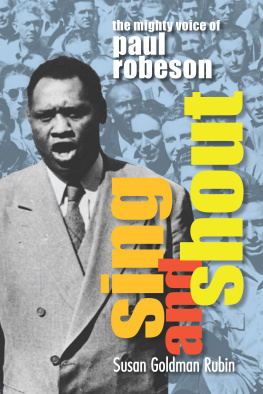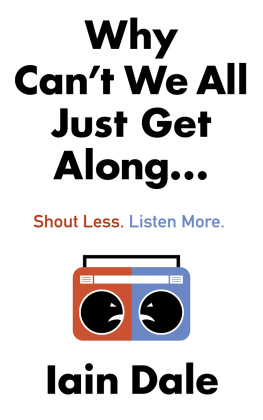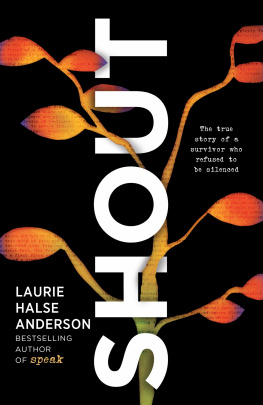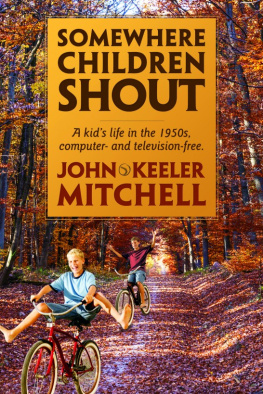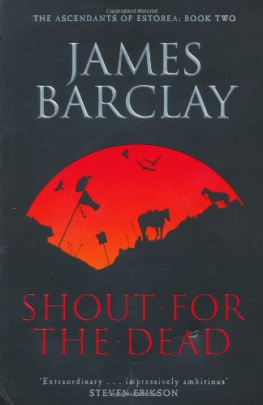Gayle Wald - Shout, Sister, Shout!: The Untold Story of Rock-and-Roll Trailblazer Sister Rosetta Tharpe
Here you can read online Gayle Wald - Shout, Sister, Shout!: The Untold Story of Rock-and-Roll Trailblazer Sister Rosetta Tharpe full text of the book (entire story) in english for free. Download pdf and epub, get meaning, cover and reviews about this ebook. year: 2007, publisher: Beacon Press, genre: Non-fiction / History. Description of the work, (preface) as well as reviews are available. Best literature library LitArk.com created for fans of good reading and offers a wide selection of genres:
Romance novel
Science fiction
Adventure
Detective
Science
History
Home and family
Prose
Art
Politics
Computer
Non-fiction
Religion
Business
Children
Humor
Choose a favorite category and find really read worthwhile books. Enjoy immersion in the world of imagination, feel the emotions of the characters or learn something new for yourself, make an fascinating discovery.
- Book:Shout, Sister, Shout!: The Untold Story of Rock-and-Roll Trailblazer Sister Rosetta Tharpe
- Author:
- Publisher:Beacon Press
- Genre:
- Year:2007
- Rating:3 / 5
- Favourites:Add to favourites
- Your mark:
- 60
- 1
- 2
- 3
- 4
- 5
Shout, Sister, Shout!: The Untold Story of Rock-and-Roll Trailblazer Sister Rosetta Tharpe: summary, description and annotation
We offer to read an annotation, description, summary or preface (depends on what the author of the book "Shout, Sister, Shout!: The Untold Story of Rock-and-Roll Trailblazer Sister Rosetta Tharpe" wrote himself). If you haven't found the necessary information about the book — write in the comments, we will try to find it.
Gayle Wald: author's other books
Who wrote Shout, Sister, Shout!: The Untold Story of Rock-and-Roll Trailblazer Sister Rosetta Tharpe? Find out the surname, the name of the author of the book and a list of all author's works by series.
Shout, Sister, Shout!: The Untold Story of Rock-and-Roll Trailblazer Sister Rosetta Tharpe — read online for free the complete book (whole text) full work
Below is the text of the book, divided by pages. System saving the place of the last page read, allows you to conveniently read the book "Shout, Sister, Shout!: The Untold Story of Rock-and-Roll Trailblazer Sister Rosetta Tharpe" online for free, without having to search again every time where you left off. Put a bookmark, and you can go to the page where you finished reading at any time.
Font size:
Interval:
Bookmark:


No, no, Im not ashamed of my blues.
Its all the same talent,
a beat is a beat whatever it is.
Thomas A. Dorsey
When you talked about Rosetta Tharpe you talked about a ball of energy. This woman would come out on the stage shed have people laughing, shed talk to them in a way that it was almost like she was related to them. And when she finished her act, they were standing. You know, they would love this woman. And she was a lovable person. I mean she was an approachable person. Even though she was a diva too, you know, because she did play the diva role.
Ira Tucker
The time: the early 1960s. The place: a television studio. The occasion: the taping of TV Gospel Time, a national program, before a live audience. A modestly dressed middle-aged woman takes the stage, launching into an improvised rendition of Up Above My Head, a church standard, accompanying herself on electric guitar. Behind her the white-robed members of a full gospel choir clap their hands in time to the music.
Up above my head, I hear music in the air
Up above my head, there is music in the air
Up above my head, music in the air
And I really do believe, really do believe joys somewhere.
Its a commanding enough performance, the woman singing and playing with jaunty confidence, despite the canned context. Then, two-thirds of the way in, during a guitar solo that serves as the bridge, something astonishing happens. The church faithful might see it as the Holy Spirit descending; for others, its that magical moment when a really fine musician becomes lost in her music and yet remains utterly in control of its effects on her audience. The woman begins moving in tandem with the guitar, alternately swaying with it, leaning into it, and rocking it gently on her hip. At one point, she executes a little jump, high heels and long dress notwithstanding; at another, she makes a dramatic circular gesture with her right arm, allowing her hand to stray promiscuously from the strings for a teasing fraction of a second. Rapidly finger-picked notes press up against full-on power chords that linger languidly in the air. She squeezes notes from the high end of the pitch, relishing the gentle fuzz of distortion, then cajoles the instrument, commanding, Lets do that again! And so the guitar soars briefly once more, eventually making a perfect, gentle landing into the final verse of the song.
The woman in question is Rosetta Tharpe, a vocalist and guitarist of the Sanctified Church and one of the most remarkableyet largely forgottenmusicians of the twentieth century. Beginning in the 1930s, she commenced a colorful career as gospels original crossover artist, its first nationally known star, and the most thrilling and celebrated guitarist of its Golden Ageso called because it saw the emergence of the genres defining artists, including Mahalia Jackson, whose fame would eclipse Rosettas by the 1950s.
Yet unlike Jackson, whose celebrity developed around her reputation as a defender of gospel tradition, Rosetta earned notoriety for her instinct for creative insubordination and her practiced talent for showbiz flamboyance. From spiritual singing that could bust out in blues cadencesand, in private, touch on blue subjectsto a guitar virtuosity that set her apart from any other performer of her era, Rosettas particular genius defied categorization. Her music incorporated elements of gospel, blues, jazz, popular ballads, country, rhythm and blues, and rock and roll. When she was at the top of her game, no one could touch her charisma or jaw-dropping talent.
Rosettas exuberant self-expression clashed with the prevailing rhythms of her time, making her the kindred spirit of secular artists such as blues singer Bessie Smith. And like the persona of Smiths celebrated Young Womans Blues, who also sang about the long lonesome road, Rosetta was often too busy living to settle down. In an age when church folk looked askance at divorce and shunned blues as the devils music, she fled an unhappy first marriage to a Pentecostal preacher to become a star in preWorld War II New York. Her ebullient spirit propelled her out of storefront churches and tent meetings and into venues such as the Cotton Club, Harlems legendary Apollo Theater, the left-leaning nightspot Caf Society, and Carnegie Hall. Rosetta played all of these places, as well as the Grand Ole Opry and arenas, stadiums, high-school auditoriums, and churches around the country. Her dazzling guitar playing, which featured a finger-picking style unusual at the time, indelibly influenced Elvis Presley, Johnny Cash, Jerry Lee Lewis, Red Foley, Etta James, Little Richard, Bonnie Raitt, Ruth Brown, Isaac Hayes, and many others.
Before the Clara Ward Singers made gospel singing glamorous, Rosetta did gospel programs in sequined gowns and a series of dye jobs or wigs of different colorssometimes she was a blonde, sometimes a redheadriding grandly into town on her own tour bus. In the socially conservative 1950s, she staged her nuptials to her third husband in a baseball stadium in Washington, D.C., entertaining a crowd of tens of thousands by playing guitar in her wedding dress. She resisted the moral severity of the Pentecostal Church, while embracing its musical values of emotional expressiveness. Her 1945 crossover hit Strange Things Happening Every Day, a humorous jab at religious hypocrisy that became a favorite of Memphis radio announcer Dewey Phillips (and subsequently of Phillips protg Elvis Presley), may well be the first rock-and-roll song. And while Mahalia made her Newport Jazz Festival debut conditional on her singing on Sunday morning, with no secular music following her performance, Rosetta took the stage at the Newport Folk Festival in the summer of 1967 garbed, as Anthony Heilbut puts it in The Gospel Sound, in unfolksy [and unseasonal] mink.
She was a woman of many guises: she could play the sincere penitent, the deep spiritualist, the saintly believer, or she could play the humorous exhibitionist, the uninhibited flirt, the needy child. Just as she crossed and recrossed the line between secular and sacred sound, so Rosetta, according to jazz critic Richard Hadlock, could at times cross into that territory normally reserved for comico-coquettish entertainers like Mae West and Pearl Bailey. No one could accuse her of disliking the grand gesture, whether histrionic tears or magnanimous, magnificent expressions of loving-kindness.
Rosettas courage to follow her artistic convictions and pursue her ambitions set her apart from popular musicians on both sides of the sacred/secular divide. In the racially segregated rural and small-town communities where most black people lived before World War II, churches were defining institutions, and ambitious young musicians confronted the parting of paths between the church and the world as crucial career turning points. Those who pursued the secular path, from Muddy Waters and T-Bone Walker to Dinah Washington and Sam Cooke, inevitably paid a price for their choices in the reproach of the very communities that had nurtured and applauded their talents. In many cases, becoming a popular entertainer meant severing ties to these communitiesif not permanently, then until success paved a golden path back into the good graces of the congregation.
Most African American musicians raised in the church had little option but to choose, as soul singer Al Green once put it, between lifting up their voices for God or taking a bow for their third encores. Rosetta, in contrast, attempted to inhabit an in-between place where the worlds of religious and popular music intersected and overlapped. She performed church hymns on secular stages. She breached standards of holiness and respectability by singing blues and jazz songs about worldly desires. Even when limiting herself to a church repertoire, she stuck out as a
Font size:
Interval:
Bookmark:
Similar books «Shout, Sister, Shout!: The Untold Story of Rock-and-Roll Trailblazer Sister Rosetta Tharpe»
Look at similar books to Shout, Sister, Shout!: The Untold Story of Rock-and-Roll Trailblazer Sister Rosetta Tharpe. We have selected literature similar in name and meaning in the hope of providing readers with more options to find new, interesting, not yet read works.
Discussion, reviews of the book Shout, Sister, Shout!: The Untold Story of Rock-and-Roll Trailblazer Sister Rosetta Tharpe and just readers' own opinions. Leave your comments, write what you think about the work, its meaning or the main characters. Specify what exactly you liked and what you didn't like, and why you think so.

